Ancient Underwater Forest in the Gulf of Mexico
Air Date: Week of July 12, 2013
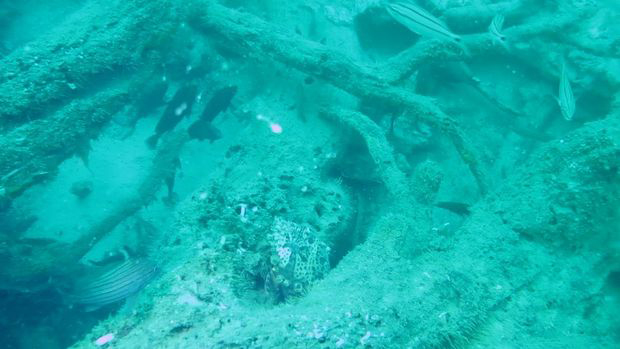
This cypress wood is over 50,000 years old (photo: Ben Raines/Alabama Press Register)
Sixty feet beneath the water off the Gulf coast of Alabama lies a forest of cypress stumps more than 50,000 years old. Ben Raines tells host Steve Curwood what it’s like to scuba dive among the remains of ancient trees.
Transcript
CURWOOD: And now let's head under the sea - not in search of mermaids, but of a long-lost forest. Deep beneath the surface of the Gulf of Mexico, off the Alabama coast, lie ancient cypress trees that only a handful of people have ever seen. One of those lucky few is Ben Raines, director of the Weeks Bay Foundation and he explained how it all came about.
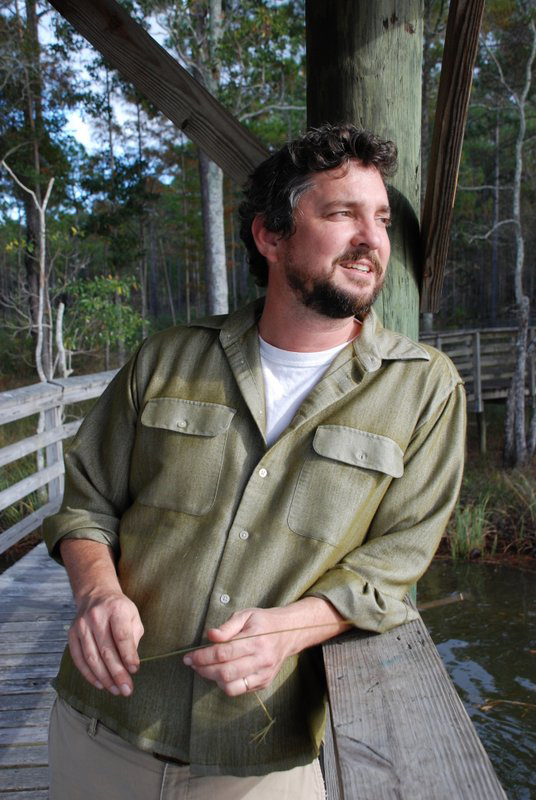
Ben Raines, director of the Week’s Bay Foundation (photo: Week’s Bay Foundation)
RAINES: For many years I was the environment reporter for the paper down here, The Press-Register, and so I had a buddy who owned a scuba diving shop, and he used to taunt me with this tale of an underwater forest that he had been diving on one time, and I pestered him for years and years and years, and he finally agreed to take me out there.
He heard about it from a fisherman who just noticed a ledge on his bottom machine as he was riding across the guif. So he started fishing there and started catching a lot of Red Snapper. And he gave the numbers, the GPS coordinates, to my buddy that owns the dive shop and asked him to go out there and see what it was. He hit the bottom and said there’s a bunch of trees.
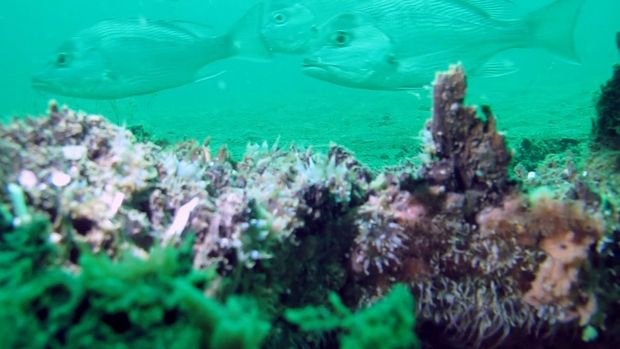
The trees have created new habitat for fish and other marine life (photo: Ben Raines/Alabama Press Register)
CURWOOD: Now how deep is deep for an underwater forest?
RAINES: Well, this is about 60 feet. Of course, all over the Earth, we know sea levels have gone down hundreds of feet. So we have a delta, a river delta here. Further up in the delta, about 80 miles inland, there’s sand dollars all over in these limestone bluffs. So we know sea level was that high at one time. Now we’ve got these trees 60 feet underwater, so sea level was that low, and it’s just a fascinating push and pull of the ocean through the climatic change over the eons.
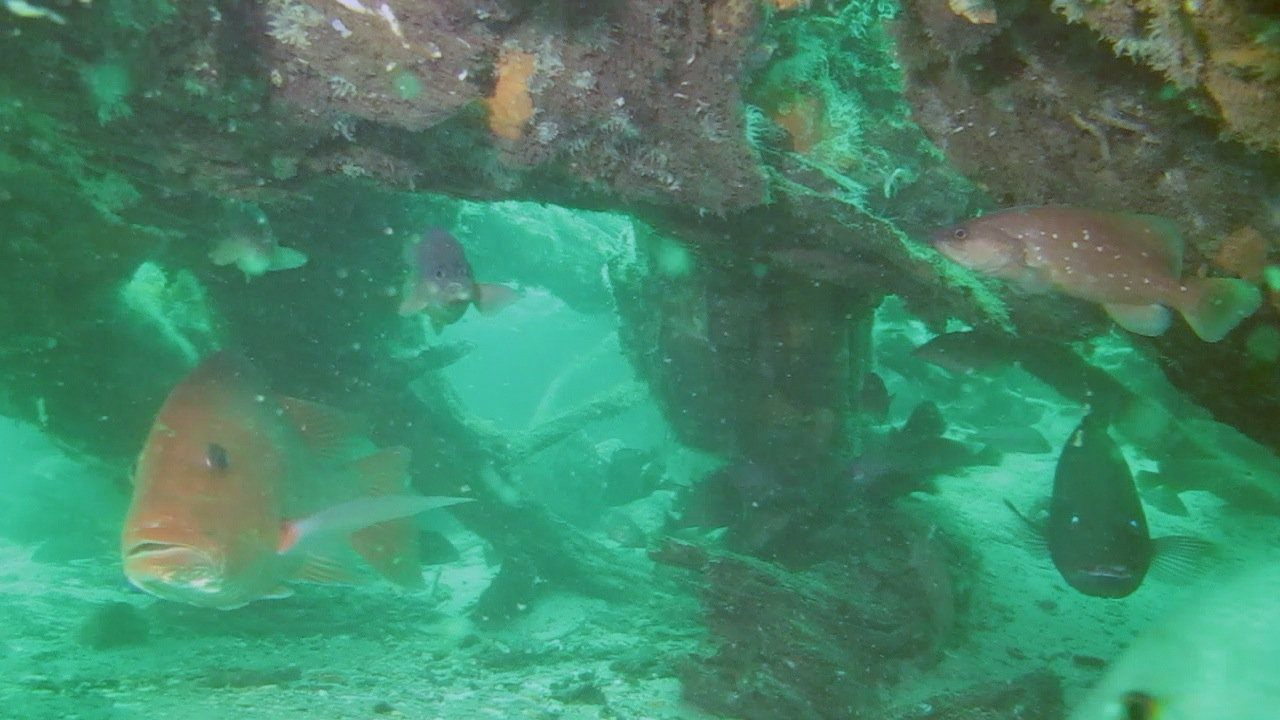
Fish hide in and among the roots of the trees (photo: Ben Raines/Alabama Press Register)
CURWOOD: So when did you finally get to visit the forest?
RAINES: I got out there a year ago last August. We went out...the first trip we tried to go out, the boat broke down. The second trip, the boat broke down.
CURWOOD: Of course. Boats always break down, don’t they?
RAINES: [LAUGHS] Absolutely. Especially my boats.
CURWOOD: [LAUGHS]
RAINES: So we finally made it out there and the way we dive here, we’ll drop the anchor over whatever the GPS number is. And then we swim down the anchor line to get to the spot because the water’s a little murky - otherwise you get lost. I went down the anchor line, and when I hit the bottom, there it was. The first stump. And it was about as big around as a garbage can lid, but it had that very distinctive irregular shape that a Cypress trunk has….
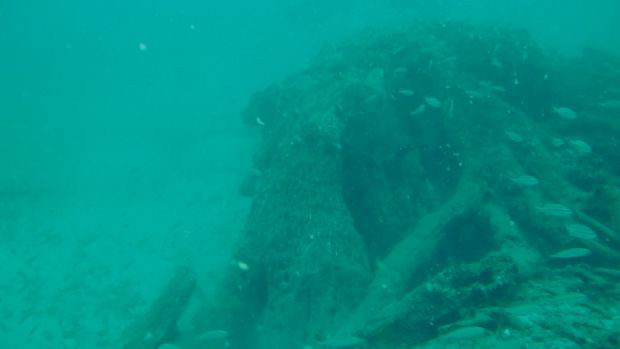
One of the many cypress stumps (photo: Ben Raines/Alabama Press Register)
CURWOOD: Uh-huh.
RAINES: …and then it was surrounded by knees. You know, Cypress trees have knees - you see them in the swamps - that stick up out of the water to kind of help hold them in place, and here was a Cypress tree on the bottom of the ocean. And I swam a few feet, and there was another one, and a few feet more, another one, and I quickly realized they were all around me in every direction.
CURWOOD: Wow. I mean, this sounds almost magical down there.
RAINES: It is absolutely magical. It’s totally enchanting. You know, these trees are covered in anemones and crabs and shrimp - and then you have these huge clouds of Red Snapper and Grouper following you around. I was down there one day swimming along the ledge where the biggest stumps are, and I turned around and there was this huge funnel shape of fish behind me, I mean it must have been 200 Snapper, and they were just following me around. When I stopped, they would stop. When I turned around, they all fell in behind me.
CURWOOD: [LAUGHS] What about the Groupers? They’re very social.
RAINES: Oh, yes. They’ll come right up to you. And some of the fish that are down there, the Trigger fish, will actually come up and chew on your camera. You have to shoo them away. They just seem to have no fear.
CURWOOD: You must have had a lot of fun because we saw this video that you made of your dive down there, and we’ll put it on our website. But have you experienced anything like that before?
RAINES: You know, I never had. I’ve been diving for some time, and from the moment I hit the bottom and saw the stumps, it was just exhilarating. You knew you were in this sort of “land of the lost”, this place that shouldn’t exist, but here it was, and I got the camera out, I hit the record button, and I never turned it off, and that’s exactly what I’ve done every dive I’ve made down there. And now I’ve been going down there with three cameras, you know, setting them up in different locations just to kind of capture this place while it’s there, because if we get a storm, it could theoretically come into the Gulf and change everything out there and bury this place up again. You know, it may be a very ephemeral place. We may only get to see it for a little while.
CURWOOD: So how old do scientists think these trees are?
RAINES: Well, I brought a few samples up, and I actually took a hand saw down there with me and cut them just like you’d cut a tree in your backyard. So I cut some sections out of them, gave them to Christine DeLong at LSU, and she had them radio carbon dated, and they had to do them three times in all I think because they didn’t believe the results. So they expected them to be 12,000 years old, which was the last ice age. Instead they came back radio carbon dead each time they tested them, which means they’re 50,000 years old or longer. So if we can...we want to get cores out of them, and then they’ll be able to count the rings and look at growth, and measure carbon inside them, things like that, and learn a lot about the past climate. We had another team come out from University of Southern Mississippi, and we had them do a sonar survey so we could try and get an extent of it because I’ve only been swimming around 300 yards of it. It turns out it’s spread close to a mile; it’s much larger than we thought, and there appear to be some much bigger stumps. I’m due to go over there next week again and see what we can - what we can ground truth some of those other locations, or sea floor truth them, I guess.
CURWOOD: Hey, Ben, how did this happen? I mean, how could these trees be preserved for so long?
RAINES: Well, any time in the ocean or anywhere else you’re able to get oxygen out of the mix, you stop decomposition. All those little bacteria and things that decay - cause decay - need oxygen, and so buried under six inches, eight inches of sand, you get into this anoxic layer where there’s no more oxygen. So these trees were covered up. We think Hurricane Katrina came through and dug this trench where the trees are now exposed, and so on the top layer of them, of the stumps, that top layer you can break it apart with your fingers - you know it’s very soft, and there’s all kinds of boring organisms digging holes in them. But once you get inside about a half-inch or an inch, then the wood’s very hard, and it’s like cutting a tree down - a living tree. And in fact, with the samples I brought up, when you cut them up in the dry air, you actually smell the smell of the sap just like you were cutting a fresh Cypress tree down. It’s really remarkable.
CURWOOD: Now that these trees have been uncovered, how will they survive?
RAINES: Well, they won’t. Ultimately, they’ll decay just like any wood that’s been sitting on the bottom of the gulf. The fact that they’re Cypress, gives them a little more longevity than other wood. Cypress is a very tough, rot-resistant wood, and for that reason, people love to make boats out of it. So, I don’t know how many years they’ll last. I can tell they’re decaying. I’ve been visiting it now for a year. And so I’ve got all these groups and companies calling me wanting to mine the logs. There’s a phenomenon called “sinker logs” where old Cypress trees that were actually so dense they couldn’t float would sink to the bottom of rivers, and there are companies now that go around and salvage these things, and they’re worth quite a lot of money. So here we’ve got the ultimate sinker logs, you know, 50,000 year old wood. So my goal is to have the place preserved before the numbers get out - the GPS numbers - so that people can go dive there, but I want it protected so they can’t go carve up the logs. I don’t want Fender and Gibson to get ahold of them and start making 50,000 year old guitars or 50,000 year old coffee tables. I’d like to see this preserved and in this enchanted little environment where people can enjoy it.
CURWOOD: So the place is still secret, those GPS numbers ain’t to be found publically, huh?
RAINES: That’s right. The place is still secret. There are very few of us who know where it is, and so far, everybody’s kept their mouths shut.
CURWOOD: Ben, it’s really clear you care about these ecosystems, and I understand you’ve been working hard on how the BP oil spill settlement money is going to be spent. Could you explain for us where we’re at in terms of that money?
RAINES: Sure. What we’re looking at right now - we’re expecting billions of dollars to come to the Gulf Coast from the Clean Water Act fines, and it’s coming through this mechanism passed by Congress called the Restore Act. This is an incredible windfall for the Gulf Coast where we seldom spend money on environmental projects of any kind. The states, environmentalists, politicians, are all lining up with pet projects they want to do.
For instance, Mississippi is looking to build a baseball stadium, Alabama is talking about building a convention center and a state park down at the beach. Nobody is talking about buying up and protecting coastal lands - at least not the way I think they ought to be. In Alaska, after the Exxon Valdez, 55 percent of the money that came from the Exxon settlement was spent buying coastal lands. We need to do the same thing down here.
So I’m advocating a nickel for the marshes - at least a nickel of every dollar of the BP money is spent buying coastal lands, because our marshes are the reason we survived the BP oil spill. They’re the reason we rebounded so quickly. Louisiana’s marshes were really just trashed, wiped out...they’re still so oily, bugs can’t live in them. Our marshes - that didn’t happen in Alabama or Mississippi or Texas or Florida - our marshes are still intact. So by preserving them we give the gulf a fighting chance - so the next time oil comes ashore somewhere - to rebound.
CURWOOD: So there you are, talking about this question with folks. What do you say is so important about protecting the gulf wetlands, you know, locking it up away from development?
RAINES: Well, the Gulf of Mexico has already lost about 50 percent of its marshland, and a lot of that’s in Louisiana, but Alabama has lost about 50 percent of its marshland. Mississippi, they built a 60-mile long man-made beach that replaced what used to be one of the longest stretches of coastal marsh in the United States. The marsh is the nursery for the Gulf of Mexico. You lose the marsh, you lose the habitat for all the shrimp, all the crab, almost everything that swims in the gulf uses these marshes at some point in its life cycle. If we don’t have marshes, we don’t have seafood, and the gulf produces about two-thirds to three-quarters of the United States’ seafood. It’s this incredible ecosystem, and it’s time now after years of beating up on it that we do something different and try to protect it.
CURWOOD: Ben Raines is director of the Weeks Bay Foundation in Fairhope, Alabama. Thanks so much for joining us.
RAINES: Thanks for having me. I really enjoyed it.
CURWOOD: Do check out Ben Raines video at our website, LOE.org. It's extraordinary!
Links
Check out a video of Ben’s dive in the cypress forest
Read Ben’s original story on the underwater forest
Living on Earth wants to hear from you!
Living on Earth
62 Calef Highway, Suite 212
Lee, NH 03861
Telephone: 617-287-4121
E-mail: comments@loe.org
Newsletter [Click here]
Donate to Living on Earth!
Living on Earth is an independent media program and relies entirely on contributions from listeners and institutions supporting public service. Please donate now to preserve an independent environmental voice.
NewsletterLiving on Earth offers a weekly delivery of the show's rundown to your mailbox. Sign up for our newsletter today!
 Sailors For The Sea: Be the change you want to sea.
Sailors For The Sea: Be the change you want to sea.
 The Grantham Foundation for the Protection of the Environment: Committed to protecting and improving the health of the global environment.
The Grantham Foundation for the Protection of the Environment: Committed to protecting and improving the health of the global environment.
 Contribute to Living on Earth and receive, as our gift to you, an archival print of one of Mark Seth Lender's extraordinary wildlife photographs. Follow the link to see Mark's current collection of photographs.
Contribute to Living on Earth and receive, as our gift to you, an archival print of one of Mark Seth Lender's extraordinary wildlife photographs. Follow the link to see Mark's current collection of photographs.
 Buy a signed copy of Mark Seth Lender's book Smeagull the Seagull & support Living on Earth
Buy a signed copy of Mark Seth Lender's book Smeagull the Seagull & support Living on Earth

